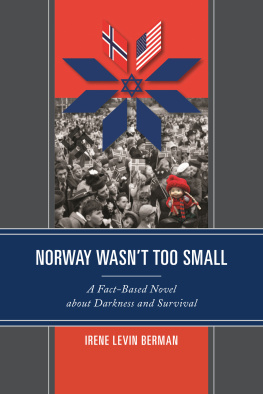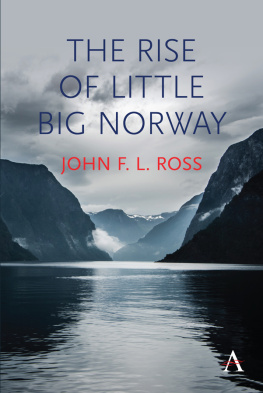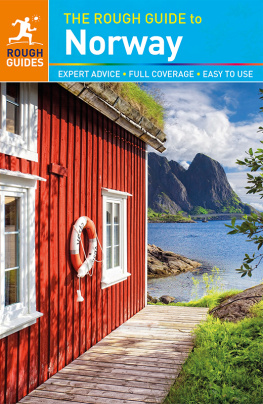The History of Norway: A Fascinating Guide to this Amazing Country
By Christopher Hughes
Copyright 2020 - All rights reserved.
The content contained within this book may not be reproduced, duplicated or transmitted without direct written permission from the author or the publisher.
Under no circumstances will any blame or legal responsibility be held against the publisher, or author, for any damages, reparation, or monetary loss due to the information contained within this book, either directly or indirectly.
Legal Notice:
This book is copyright protected. It is only for personal use. You cannot amend, distribute, sell, use, quote or paraphrase any part, or the content within this book, without the consent of the author or publisher.
Disclaimer Notice:
Please note the information contained within this document is for educational and entertainment purposes only. All effort has been executed to present accurate, up to date, reliable, complete information. No warranties of any kind are declared or implied. Readers acknowledge that the author is not engaging in the rendering of legal, financial, medical or professional advice. The content within this book has been derived from various sources. Please consult a licensed professional before attempting any techniques outlined in this book.
By reading this document, the reader agrees that under no circumstances is the author responsible for any losses, direct or indirect, that are incurred as a result of the use of information contained within this document, including, but not limited to, errors, omissions, or inaccuracies.
Introduction
The Prehistoric History of Norway
The Viking Age of Nordic History
The Middle Ages in Norway
Dissolved Unions and Adjoined Countries
The History of Norway during the Napoleonic Wars
The Industrialization of Norway
Norway, its own Government
The Present History of Norway
The Current Economy of Norway
The Current Infrastructure of Norway
The Military and Diplomacy of Norway
Conclusion
References
T here is a certain air surrounding the Northern European countries. Perhaps it is due to the strong history uniting these countries. Perhaps it is because of the climate that makes these countries more mysterious. Whatever the case, the history of all Northern European countries is something that will keep anyone entertained and intrigued during its review. Nestled in the Southern portion of the peninsula that also contains Sweden, Norway has long been regarded as a country still wedged in its heritage. When reviewing its history, one cannot help but notice that the controlling force of its success has largely been the climate hovering over the country. The countrys greatest transformation came during the era of history around 10,000 BC. Prior to this time period, the country had been mostly covered by massive sheets of ice that kept it frozen and uninhabitable; however, the turn of 10,000 BC offered a different atmosphere in the area, directly resulting in the removal of the ice sheets. When inhabitants of nearby Sweden and other countries saw the new land, the migration into Norway became inevitable. With a warm Gulf Stream maintaining a constant melt of the ice that had once surrounded and submerged the country in a frozen lake, the earliest inhabitants of Norway were now free to build their families around farms and other plots of land that were extremely fertile. While there was an aura of excitement surrounding the earliest settlers, there was also a fair amount of anxiety and an even greater amount of hard work needed. The area had never been lived in prior so no settler had even the slightest idea of what each change in season would bring. Survival in the new country was contingent on a mans ability to take the resources around him and fashion them into substitutes from the life the settlers had migrated from.
With a selection of animals such as reindeer and fish providing meat, the settlers did not go hungry. Within this new land (yet to be named Norway), the most livable area appeared to be a beautiful inlet known as the Oslofjord. With a water supply that was surrounded by mountains and beautiful scenery, the settlers of Norway were content with the conditions of the land. At the turn of 1500 BC, the settlements began to seep beyond the Oslofjord, gradually creeping into the southern portions of Norway and away from the security of the bordering countries. From here on, there was no room for failure. These settlers would be on their own and their survival was entirely contingent on their ability to overcome the unknown conditions that awaited them.
The history of Norway has been divided into numerous eras. In 4000 BC, the Neolithic Period of Norwegian history took place. Until the Migration Period of 375, there was no notable history that emanated from Norway; however, the surge of the Migration Period in 375 gave Norway its first forms of an informal government. All over the country, chieftains came to rule the various tribes, allowing formidable defenses to be made. The turn of the 8th century saw Norway seep beyond the boundaries that even the ocean had made, entering nearby countries such as Iceland and developing colonies in the respective countries. A movement that did not originate in Norway but affected it nonetheless was the Viking Age, which started in Scandinavia. With the government overrun by Vikings, the government of Norway became more united than ever and the countrys exports and individual governments began to flourish. This period of history saw the greatest growth come to the Norwegian population. Unfortunately, the coming months of the Black Plague in 1349 would see this growth completely decimated. In all, more than 50% of the population of Norway would succumb to the Black Plague.
As the country attempted to regroup following the destruction that befell its population, it would establish ports at Bergen and surrounding areas, Bergen becoming the primary trading port and managed by the Hanseatic League. In 1397, the government of Norway joined ranks with Sweden and Denmark when the countries established the Kalmar Union, uniting the three countries and eventually leading to much financial prosperity through the acquisition of Iceland. Less than two hundred years later, Sweden would remove itself from the Kalmar Union, leaving Denmark and Norway to rule Iceland and share the wealth. Additionally, the Reformation began sweeping across Europe during this time, causing a great transformation to the countrys economy. The government of Norway transitioned to an absolute monarchy in the late 1600s and the result would be even more control by the Norwegian government. Up until this point, Norways government had been mostly comprised of smaller governments primarily controlled by the chieftains of each tribe. With the addition of the absolute monarchy, more stability came to the country and the citizens found the economic surge rewarding.
In 1814, Norway lost much of its prowess with the conclusion of the Napoleonic Wars, a loss that would result in the succession of its government to Sweden. Shortly after, Norway would attempt to circumvent this succession by declaring itself independent and writing its own constitution. This was to no avail as many countries were more concerned with the power of Sweden. The result of this failure would be Norways forced compliance with the Treaty of Kiel. The ensuing days would see war, more failure, and more demise for the countrys morale. With the government of Norway unwilling to comply with the Treaty of Kiel, Sweden declared war on Norway and the two countries engaged in short but bloody war. The war would end at the Convention of Moss where Norway was given the freedom to maintain its written constitution. With the constitution and a recognized independence apart from a few services, Norway was left to unite its kingdom under one king, its first elected King being Charles XIII of Sweden.
Next page















